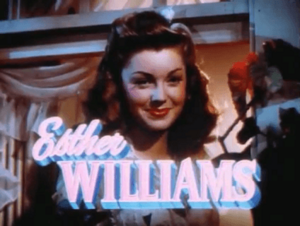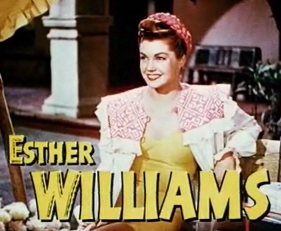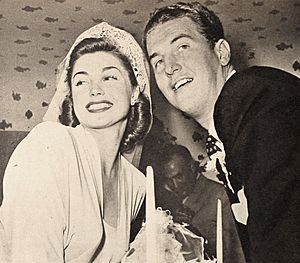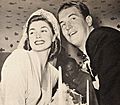Esther Williams facts for kids
Quick facts for kids
Esther Williams
|
|
|---|---|
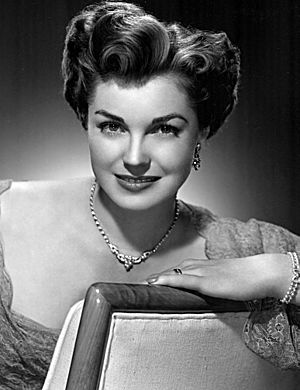
Williams in 1950
|
|
| Born |
Esther Jane Williams
August 8, 1921 Inglewood, California, U.S.
|
| Died | June 6, 2013 (aged 91) |
| Alma mater | Los Angeles City College |
| Occupation |
|
| Years active | 1942–1963 |
| Spouse(s) |
Leonard Kovner
(m. 1940; div. 1944)Ben Gage
(m. 1945; div. 1958)Edward Bell
(m. 1994) |
| Children | 3 |
Esther Jane Williams (born August 8, 1921 – died June 6, 2013) was an American swimmer and famous actress. When she was a teenager, she set many swimming records across the country. She was supposed to compete in the 1940 Summer Olympics, but the games were cancelled because of World War II.
After the Olympics were cancelled, Esther joined a big water show called Billy Rose's Aquacade. There, she swam alongside Johnny Weissmuller, who was an Olympic gold medalist and also played Tarzan in movies! While performing, talent scouts from Metro-Goldwyn-Mayer (MGM), a big movie studio, noticed her.
Esther Williams became known for her special movies called "aquamusicals." These films were made in the 1940s and early 1950s. They featured amazing swimming and diving performances, often with synchronised swimming. Many of her movies were very popular. In 1952, she played a real-life swimming star named Annette Kellermann in the movie Million Dollar Mermaid. This movie was so famous that "Million Dollar Mermaid" became Esther's nickname!
After leaving MGM in 1956, Esther appeared in a few more movies and some popular TV specials that featured water shows. She was also a smart businesswoman. She invested in different companies and even had her own line of swimming pools, retro swimwear, and swimming videos for kids. She also worked as a commentator for synchronized swimming at the 1984 Summer Olympics.
Contents
Early Life and Swimming
Esther Jane Williams was born on August 8, 1921, in Inglewood, California. She was the youngest of five children. Her parents, Louis and Bula Williams, had moved to California from Kansas.
Esther loved swimming from a young age. Her older sister, Maurine, often took her to Manhattan Beach and to the local pool. To pay for her five-cent entry fee at the pool, Esther got a job counting towels. While working there, she learned how to swim from the lifeguards. She even learned special swimming strokes, like the butterfly stroke, which helped her break records later on.
Competitive Swimming Achievements
Esther became a very strong swimmer. In 1939, her team set a record for the 300-yard relay at the Los Angeles Athletic Club. She also became a national champion in the 100-meter freestyle, setting a record time of 1 minute and 9 seconds. By the time she was 16, Esther had won three national championships in swimming.
She graduated from Washington Preparatory High School in Los Angeles in 1939. She was even the class vice president and later president! Esther hoped to go to the University of Southern California on a scholarship to study physical education. However, she got a low grade in algebra, which meant she couldn't get the scholarship. So, she went to Los Angeles City College to retake the course. To earn money for her studies, Esther worked at a department store called I. Magnin. She modeled clothes and appeared in newspaper ads.
While working at the store, Esther was asked to audition for Billy Rose's Aquacade show. She got the part and became partners with Olympic swimmer Johnny Weissmuller. Esther stayed with the show until it closed in September 1940. She had planned to compete in the 1940 Summer Olympics, but they were cancelled because World War II had started.
Becoming a Movie Star
It was at the Aquacade show that movie scouts from Metro-Goldwyn-Mayer (MGM) first noticed Esther. The head of MGM, Louis B. Mayer, wanted a female sports star for his studio, similar to the ice skating star Sonja Henie at another studio. Esther signed a contract with MGM in 1941.
Her contract had two special rules: she could swim every day at The Beverly Hills Hotel pool, and she wouldn't appear in movies for nine months. This time was for her to take lessons in acting, singing, dancing, and speaking clearly. Esther said it was like her "birth" from a swimmer to a movie actress.
During World War II, many stars helped by visiting hospitals to entertain soldiers. Esther, who was very popular for her swimsuit photos, also visited hospitals. She would tell jokes and invite soldiers to do fun, pretend screen tests with her. She would even surprise them by revealing a sparkly swimsuit! These visits continued into the 1950s.
Early Films and Aquamusicals
Esther's first screen test was directed by George Sidney. After appearing in a few short films, she had a role in Andy Hardy's Double Life. Then she had a small part in A Guy Named Joe, where she first worked with Van Johnson. They would later star in five more movies together.
Her first big musical film was Bathing Beauty (1944). In this movie, Red Skelton plays a man who goes to a women's college to win back his swimming instructor fiancée, played by Esther. The studio changed the movie's title to highlight Esther. Posters for the film often showed her in a bathing suit, even though the swimming scenes were only a small part of the movie.
Esther also appeared in Ziegfeld Follies as herself. Then came the musical Thrill of a Romance (1945), where Van Johnson played a war veteran who falls in love with Esther's character. This movie was the 8th highest-grossing film of 1945.
In 1946, Esther tried a more serious role in The Hoodlum Saint. She also starred in Easy to Wed, a remake of an older film, with Van Johnson and Lucille Ball. This was the first time Esther sang in a movie!
In Fiesta (1947), Esther played the twin sister of Ricardo Montalbán's character. She pretended to be her bullfighting brother to get him to come home.
After Fiesta, Esther starred in This Time for Keeps (1947) with singer Johnnie Johnston. In 1948, Esther signed a deal with Cole of California, a swimwear company. She became their spokesperson, and the swimsuits in her movies were from Cole. These new swimsuits were much better than the heavy ones she used to wear, which could drag her down in the water! She even helped the United States Navy get better swimsuits for women in the WAVES program.
In 1949, Esther made Take Me Out to the Ball Game with Gene Kelly and Frank Sinatra. She played the owner of a baseball team. The film was very successful. Around the same time, she made Neptune's Daughter with Ricardo Montalbán and Red Skelton. In this movie, Esther sang "Baby, It's Cold Outside" with Montalbán. This song won an Academy Award for Best Original Song! Neptune's Daughter was the 10th highest-grossing film of 1949.
1950s Films
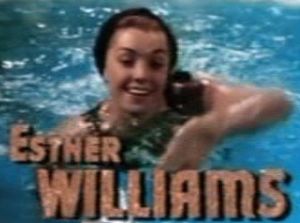
Esther made Duchess of Idaho (1950) with Van Johnson. She also starred with Howard Keel in three films: Pagan Love Song (1950), Texas Carnival (1951), and Jupiter's Darling (1955).
Her favorite film was Million Dollar Mermaid (1952), where she played the real-life Australian swimming star Annette Kellermann. Esther even named her autobiography after this movie. She won an award at the 1952 Golden Globes for being the World Film Favorite – Female.
Easy to Love (1953), also with Van Johnson, was filmed at Cypress Gardens in Florida. A swimming pool shaped like the state of Florida was built just for the movie! Esther was pregnant during filming but still did all her own water-skiing stunts.
In Dangerous When Wet (1953), Esther worked with the cartoon characters Tom and Jerry and her future husband Fernando Lamas.
Making her movies often involved risks. While filming Million Dollar Mermaid, she broke her neck doing a 115-foot dive and was in a body cast for seven months. She also ruptured her eardrums many times from being underwater for so long. Once, she almost drowned because she couldn't find a trapdoor in a dark tank. Luckily, a crew member noticed and pulled her out.
After MGM
After 15 years, Esther left MGM in 1956 because she didn't want to take a role in a film called The Opposite Sex. This meant she lost a lot of money she had saved up from her contract.
She then made a non-musical film called The Unguarded Moment (1956). Her film career slowed down after this, partly because her husband, Fernando Lamas, preferred her not to continue making movies. However, she still appeared on TV shows like What's My Line? and The Ed Sullivan Show, and in two popular water-themed TV specials. In 1966, Esther Williams was honored by being added to the International Swimming Hall of Fame.
Later Life and Legacy
Esther Williams stopped acting in the early 1960s. She later turned down a role in the movie The Poseidon Adventure, which involved a crucial swimming scene. The role went to Shelley Winters instead.
She continued to be involved in business, especially with her line of retro swimwear. She believed her swimsuits helped women feel confident and supported. She also had a company that made swimming pools and accessories. Esther created "Swim, Baby, Swim" videos to help parents teach their children how to swim.
In 1999, she wrote her autobiography, The Million Dollar Mermaid, with author Digby Diehl. In 1994, she appeared in the movie That's Entertainment! III, which looked back at classic Hollywood films.
Esther Williams died peacefully in her sleep on June 6, 2013, at the age of 91. Her ashes were scattered in the Pacific Ocean.
Many people remembered her after her death. CNN quoted her International Swimming Hall of Fame biography, saying that her movie career helped make swimming popular for fun, health, and safety. Her stepson, Lorenzo Lamas, called her "The best swim teacher and soul mom." Film historian Leonard Maltin said she was "a major, major star, a tremendous box office attraction."
For her contributions to movies, Esther Williams has a star on the Hollywood Walk of Fame. She also left her hand and footprints at Grauman's Chinese Theatre in 1944.
Her life and career were even featured in a Swedish book called Esther Williams — Skenbiografin (Esther Williams: The Fake Biography) in 2000. In 2016, the character DeeAnna Moran in the film Hail, Caesar! had many similarities to Esther Williams, especially being a pregnant aquamusical star.
Personal Life
Esther Williams was married four times. Her first marriage was to Leonard Kovner in 1940. They divorced in 1944.
She married singer and actor Ben Gage on November 25, 1945. They had three children: Benjamin Stanton (born 1949), Kimball Austin (born 1950, died 2008), and Susan Tenney (born 1953). They separated in 1952 and divorced in 1959.
Esther married Argentine actor and director Fernando Lamas on December 31, 1969. They remained married until his death in 1982.
Her fourth husband was actor Edward Bell, whom she married on October 24, 1994. She lived in Beverly Hills with him.
Filmography
| Year | Title | Role | Notes |
|---|---|---|---|
| 1942 | Andy Hardy's Double Life | Sheila Brooks | |
| 1943 | A Guy Named Joe | Ellen Bright | |
| 1944 | Bathing Beauty | Caroline Brooks | |
| 1945 | Thrill of a Romance | Cynthia Glenn | |
| 1945 | Ziegfeld Follies | Herself | ('A Water Ballet') |
| 1946 | The Hoodlum Saint | Kay Lorrison | |
| 1946 | Easy to Wed | Connie Allenbury Chandler | |
| 1947 | Fiesta | Maria Morales | |
| 1947 | This Time for Keeps | Leonora 'Nora' Cambaretti | |
| 1948 | On an Island with You | Rosalind Reynolds | |
| 1949 | Take Me Out to the Ball Game | K.C. Higgins | |
| 1949 | Neptune's Daughter | Eve Barrett | |
| 1950 | Duchess of Idaho | Christine Riverton Duncan | |
| 1950 | Pagan Love Song | Mimi Bennett | |
| 1951 | Texas Carnival | Debbie Telford | |
| 1952 | Skirts Ahoy! | Whitney Young | |
| 1952 | Million Dollar Mermaid | Annette Kellerman | |
| 1953 | Dangerous When Wet | Katie Higgins | |
| 1953 | Easy to Love | Julie Hallerton | |
| 1955 | Jupiter's Darling | Amytis | |
| 1956 | The Unguarded Moment | Lois Conway | |
| 1958 | Raw Wind in Eden | Laura | |
| 1961 | The Big Show | Hillary Allen | |
| 1963 | Magic Fountain | Hyacinth Tower | |
| 1994 | That's Entertainment! III | Herself |
| Year | Title | Role | Notes |
|---|---|---|---|
| 1955 | What's My Line | Guest Celebrity | Episode: "16 January 1955" |
| 1957 | Lux Video Theatre | Vicki | Episode: "The Armed Venus" |
| 1960 | The Donna Reed Show | Molly | Episode: "The Career Woman" |
| 1960 | Dick Powell's Zane Grey Theatre | Sarah Harmon | Episode: "The Black Wagon" |
| 1961 | The Bob Hope Show | Episode: "The Bob Hope Buick Sports Awards Show" |
Images for kids
-
Williams, Van Johnson and Carleton G. Young in Thrill of a Romance (1945)
See also
 In Spanish: Esther Williams para niños
In Spanish: Esther Williams para niños


